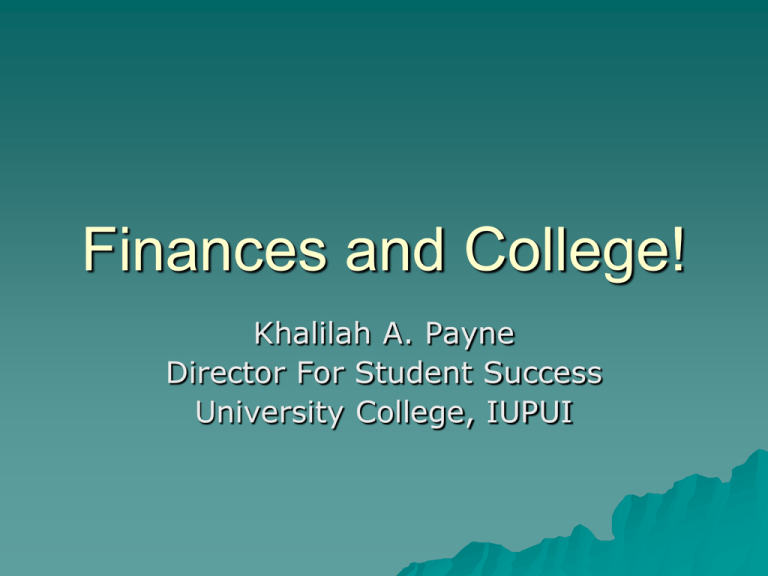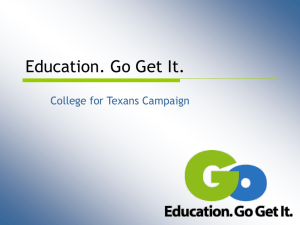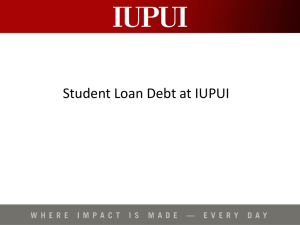Student Finances
advertisement

Finances and College! Khalilah A. Payne Director For Student Success University College, IUPUI This presentation… Financial Aid overview Balancing Being work and school financially literate! Overview of Financial Aid Submission of the FAFSA is required yearly to be considered for financial aid. Cost of attending IUPUI (Financial Aid COA)– Includes tuition/fees, books/supplies, room/board, transportation, personal/miscellaneous expenses. In 2007 17,618/29,854 (59%)IUPUI students applied for financial aid and 15,176 (51%)received it. For more information visit http://www.iupui.edu/~finaid/ Sources of Financial Aid Federal grants – Pell – ranges from $400 to $4731 (max) based on EFC. Scholarships – Institutional – both merit and need based - $16,208,555 to 8356 students – does not include athletics. Continuing Student Scholarship opportunities Departmental scholarship awards – Private –limited funding Community based awards – through churches, organizations, etc. Work Study – Student can work various on and off campus jobs – see jagjobs.org Loans – Subsidized loans – govt. pays interest while attending – Unsubsidized loans – interest accrued while attending More info on student loans: Good or Bad? Federal Loans – Now the largest source of aid – 70% (federal family education and direct loans). – Average loan debt of a college grad is $18,629. – Federal loan interest rate roughly 6% for 08-09. – Deferred payments until graduation Private Loans – Interest rates upwards of 18% - based on credit – Some go into repayment while still enrolled Loans as an investment? Consider the value of a college degree based on difference in income. – High school grad earns about $30,400 – College grad earns about $52,200 Balancing work and school Employed while attending The more hours worked – the more the negative effect on grades and experience Cumulative GPA declines in correlation to the number of hours worked each week. 46% of students work 25 or more hours 63% of full-time students who work say that if they didn’t work – they couldn’t afford college. 1 in 5 work 35 hours or more per week Work and financial aid Govt. income forgiveness - $2300 – For every dollar over, .50 is counted toward students contribution. – This can impact the students financial aid package. – This information will differ based on dependency status (Independent vs dependent students) Student must work to balance financial obligations due to unmet need and lack of financial management skills. The expected family contribution has increased because the student has more income possibly resulting in decreased financial aid and increased student loans. Working student exceeds the government’s income forgiveness limit of $2300. For every dollar over the limit – the student is expected to contribute $.50 to the cost of their education. Financial Literacy What is it? Definitions??????? Financial Literacy Defined… Financial literacy is the ability to read, analyze, manage, and communicate about the personal financial conditions affecting material wellbeing. It includes the ability to make financial choices, understand money and financial issues, plan for the future, and respond to life events. --Personal Finance and the Rush to Competence. If you are going to graduate... You must be knowledgeable about your finances. It is a big deal… Financial Literacy and Education Commission People in the 18-24 age bracket spend nearly 30% of their income on debt repayment. Young adults spend $1.22 for every $1.00 earned. Student Finances Credit Card debt – 83% of students have at least 1 credit card – Average balance is $2327 – Midwesterners carry the highest average credit card balances – Read the fine print – regarding annual fees, cash advance fees, late fees, over-limit fees, etc. – Minimum payment traps – a balance of $2000 with an 18% APR – paying 3% (min payment) will take 11 years to pay off and cost an additional $1654 in interest. Some other useful info… Bankruptcy – In 2001 – 6.9% of filers were 18-24 yrs old and 29% were 25-34. Over 150,000 filers. Free credit report – Freeannualcreditreport.com is the only government supported website to obtain a free credit report. Protecting your identity – Frequently change your passwords/pins Avoiding predatory lending – They are marketing you – a vulnerable population – Types include check cashing stores, payday loans, rent-to-owns. Needs vs wants! Some tips to start thinking wiser about your financial profile. Purchases Living in last week? expenses that you expect to have while in college? 5 Top Areas of Expenses Communication Books/supplies Recreation/Entertainment Food Transportation Find alternatives to spending lots of money in the areas above. “Many people assume that it’s normal to be unable to control their money. It’s not. Money abuse is the inability to control excessive debt or spending. It is a recurrent, often unconscious, use of money to overcome underlying issues.” --Steve Rhode, President, Co-founder MyVesta Financial Health Centers Being financially literate Overall financial management knowledge is critical. Budgeting, planning, saving – keys to financial freedom. Get help if you have uncontrollable spending habits or don’t know how to balance or budget. Free courses on financial literacy www.nslpflonline.org Mymoney.gov – another online resource! Thanks… Questions or Comments Khalilah A. Payne kapayne@iupui.edu (317) 278-6856


